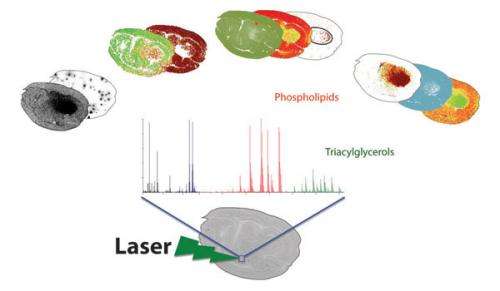New technique yields never-before-seen information critical to biofuels research

(�鶹��Ժ) -- Pioneering mass spectrometry methods developed at Ames Laboratory are helping plant biologists get their first glimpses of never-before-seen plant tissue structures.
The new method opens up new realms of study, ones that might have long-ranging implications for biofuels research and crop genetics.
“The data we’re seeing are unprecedented,” said Basil Nikolau, the Ames Laboratory faculty scientist heading up the project, funded by DOE’s Office of Science.
The laboratory’s team of researchers has developed a new more highly sensitive mass spectrometry technique to investigate metabolites, the small molecules that are the building blocks for plant biological processes.
Young-Jin Lee, a faculty scientist in Ames Laboratory’s Chemical and Biological Sciences Division, has successfully demonstrated the use of matrix-assisted laser deposition/ionization-mass spectrometry, or MALDI-MS, to map the lipids in cottonseed in a recent paper published in The Plant Cell, a premier research publication in plant science.
The research group’s technique is also featured in a paper published in a special issue of The Plant Journal, highlighting new developments in high resolution measurements in plant biology. The imaging technique can make maps of the locations of molecules in plant materials with resolution of 10 to 50 microns, less than a quarter the size of a human hair.
MALDI-MS has been in use in the medical and pharmaceutical fields for about the last decade, Lee said.
“In the medical field researchers were using this type of spectrometry to map proteins in human cancers and visualize the distribution of drugs through tissues. But in recent years the scientific community began to look at MALDI-MS as a possibility for mapping metabolites in plant material,” said Lee.
Traditional methods in gas chromatography and mass spectrometry told plant biologists the “what and how much” of plant metabolites, but not the “where.”
“Before these advances, in order to analyze plant material, biologists were forced to crush up tissue. We would lose spatial information, where these metabolites were located in different types of plant cells,” said Nikolau.
“The traditional methods provided qualitative and quantitative analysis, but it lost all localization of these small molecules,” said Lee. “With this technique we can see the distribution of these metabolites in the plant tissue at the single cell level.”
In Lee’s study of cottonseeds, done in partnership with a team of U.S. and German scientists, the technique showed a distribution of lipids that varies with tissue function. The knowledge could yield useful information about cottonseed, a crop valued as a possible source of biofuel and for its oil in the food industry.
“This information is really so new to scientists that we don’t know yet what it means. As a matter of fact, it challenges plant biologists at the moment to take hold of that data and integrate it into the way they do their science,” said Nikolau. “This data will change the future of how we do research.”
Lee said that though there was still much to learn about developing procedures using MALDI-MS to detect the tiny amounts of material in cells, he expects the use of the technique in plant science to gain wider use.
“Up until this point, this method has not really been recognized by plant scientists. But we were able to bring the technologies of analytical chemistry to the biological science problem of being able to map molecules at the single cell level. There is still a lot to learn about the process, but this technique is going to blossom very rapidly in the next few years.”
Nikolau believes the technology will be a key to thoroughly understanding plant biosynthesis, and in turn alternative energy production.
“This is really about the sustainability of our chemical world,” he said. “When you’re talking about chemical energy, you’re talking about carbon. Historically, over the last 100 years, it’s been carbon from petroleum. If you’re going to make biorenewable chemicals, the carbon comes in through photosynthesis, through plants. That process happens in discrete compartments within the organism, within individual cells. Science needs to know that highly detailed spatial information to take full advantage of it.”
Provided by Ames Laboratory

















